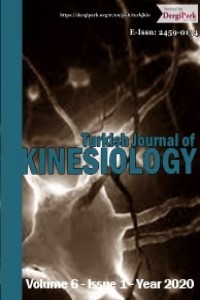Relationship among chest expansion and scapular index in smartphone users
Relationship among chest expansion and scapular index in smartphone users
Duration, Chest expansion, scapular index, Smartphone,
___
- Abdelhameed, A. A. & Abdel-Aziem, A. A. (2016). Exercise training and postural correction improve upper extremity symptoms among touchscreen smartphone users. Hong Kong Physiotherapy Journal, 35, 37-44.
- Alonazi, A. (2017). The effects of frequent smartphone use on children’s upper posture and pulmonary function [Doctoral dissertation, Loma Linda University]. Loma Linda University Electronic Theses, Dissertations & Projects. https://scholarsrepository.llu.edu/etd
- Balakrishnan, R., Chinnavan, E., & Feii, T. (2016). An extensive usage of hand held devices will lead to musculoskeletal disorder of upper extremity among student in AMU: A survey method. Int J Phys Educ Sports Health, 3(2), 368-372.
- Dalawala, P. J. & Pimpale, S. K. (2017). Assessment of craniovertebral angle and depression in heavy smartphone users. Indian Journal of Physiotherapy & Occupational Therapy, 11(4), 88-92.
- Debouche, S., Pitance, L., Robert, A., Liistro, G., & Reychler, G. (2016). Reliability and reproducibility of chest wall expansion measurement in young healthy adults. Journal of Manipulative and Physiological Therapeutics, 39(6), 443-449.
- Eitivipart, A. C., Viriyarojanakul, S., & Redhead, L. (2018). Musculoskeletal disorder and pain associated with smartphone use: A systematic review of biomechanical evidence. Hong Kong Physiotherapy Journal, 38(02), 77-90.
- Gupta, M., Dashottar, A. & Borstad, J. D. (2013). Scapula kinematics differ by body mass index. J Appl Biomech, 29(4), 380-385.
- Janssens, J.-P., Pache, J.-C., & Nicod, L. (1999). Physiological changes in respiratory function associated with ageing. Eur Respir J, 13(1), 197-205.
- Jung, S. I., Lee, N. K., Kang, K. W., Kim, K., & Do, Y. L. (2016). The effect of smartphone usage time on posture and respiratory function. J Phys Ther Sci, 28(1), 186-189.
- Kim, E.-K. & Kim, J. S. (2016). Correlation between rounded shoulder posture, neck disability indices, and degree of forward head posture. J Phys Ther Sci, 28(10), 2929-2932.
- Kim, Y.-G., Kang, M.-H., Kim, J.-W., Jang, J.-H., & Oh, J.-S. (2013). Influence of the duration of smartphone usage on flexion angles of the cervical and lumbar spine and on reposition error in the cervical spine. Physical Therapy Korea, 20(1), 10-17.
- Koseki, T., Kakizaki, F., Hayashi, S., Nishida, N., & Itoh, M. (2019). Effect of forward head posture on thoracic shape and respiratory function. J Phys Ther Sci, 31(1), 63-68.
- Lee, S., Kang, H., & Shin, G. (2015). Head flexion angle while using a smartphone. Ergonomics, 58(2), 220-226.
- Masoumi, A. S. and M. Akoochakian (2019). The effect of duration of smartphone use on head and shoulders posture of young adults aged 20-35 years. Iran J Ergon, 7(2), 62-71.
- Salvi, R., & Battin, S. (2018). Correlation of mobile phone addiction scale (MPAS) score with craniovertebral angle, scapular index and beck's depression Inventory score in young adults. Int J Physiother, 5(1), 7-12.
- Shete, M. G., & Shah, R. (2019). Effect of posture correction exercises and ergonomic advices in people having postural abnormalities among chronic smartphone users. International Journal of Health Sciences & Research, 9(7), 121-125.
- Vijayakumar, M., Mujumdar, S., & Dehadrai, A. (2018). Assessment of co-morbid factors associated with text-neck syndrome among mobile phone users. IJSRST, 4(9), 38-46.
- Vora, T., Goda, K., Dhole, N., Verma, C., & Vichare, S. (2019). Study of the association between scapular position and mobile phone usage in college students: An observational descriptive study. Physiother - J Indian Assoc
- Physiother, 13(1), 18-22. Zafar, H., Albarrati, A., Alghadir, A. H., & Iqbal, Z. A. (2018). Effect of different head-neck postures on the respiratory function in healthy males. BioMed Research International, 2018, 4518269.
- Yayın Aralığı: 4
- Başlangıç: 2015
- Yayıncı: Nurtekin Erkmen
Play vs exergaming: A conceptual analysis as to why exergaming is not play
The relationship between powerlifting performance and hand grip strength among female athletes
Relationship among chest expansion and scapular index in smartphone users
Dr. Qurat Ul Ain GOHAR, Sılwat SULTANA, Maria INTİKHAB, Hina LATİF, Dr. Saba MURAD, Dr. Muhammad Furqaan YAQOOB
